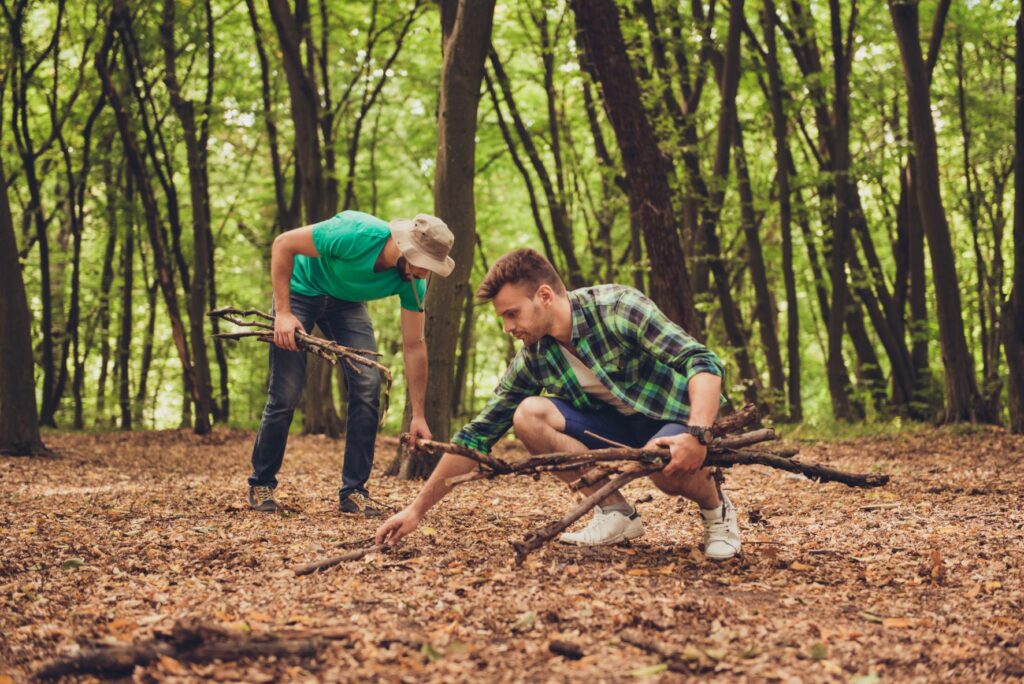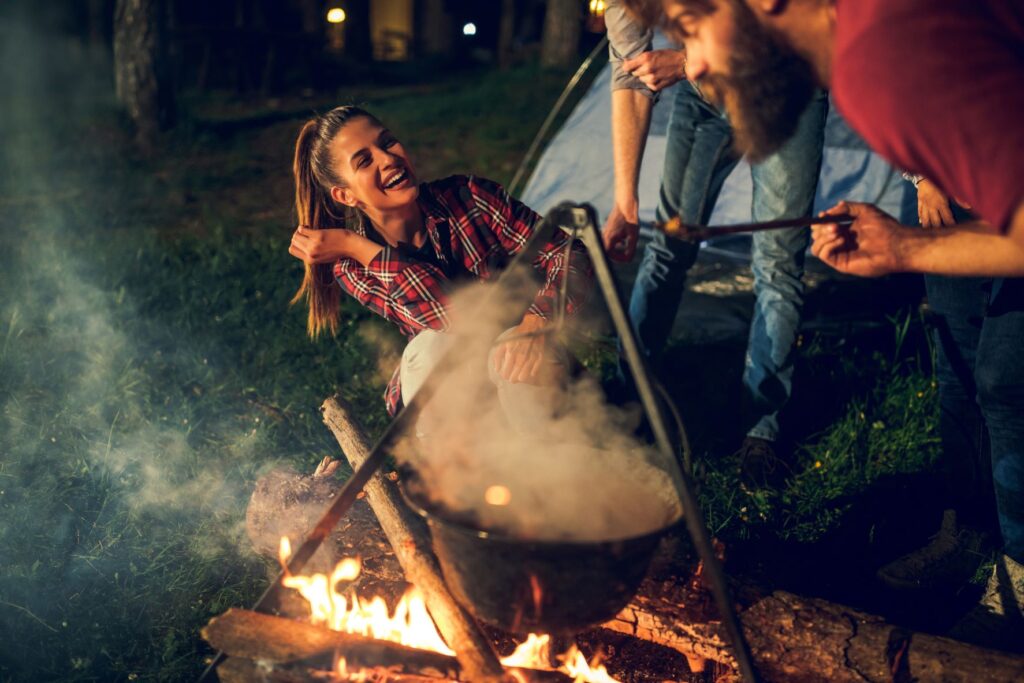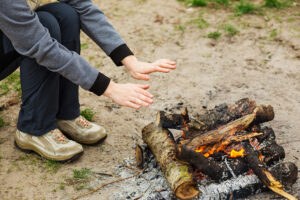From the time that humans first discovered fire, we have been drawn to its warmth, light and function. Across all cultures and continents, we share the desire to sit with family and friends around an open campfire enjoying stories, laughter and food. You may be headed out for a camping trip or maybe you are fortunate enough to live on a property where you are allowed to make a campfire. If so, then maybe you are new to the art of fire-making. The experience of building a campfire can be very rewarding when all goes well, but it can be a bit frustrating if you have been kneeling next to the campfire ring with smoke in your eyes trying unsuccessfully to achieve that warm bright glow. With some basic knowledge and some reliable materials and equipment, you can impress your friends and family by quickly getting a smokeless fire going at your next evening get together.
Campfire Safety
Before setting up your campfire, be sure to consider your safety and the safety of your guests and the environment. If the weather has been very dry you should carefully look around the area of your campfire. Do you see lots of dead, dry grass or leaves? Is there a strong wind blowing? Sparks from a campfire can very easily blow out of the campfire ring and onto dry grass and leaves nearby. Once these are ignited, the wind can blow the small flame into a large forest or grass fire very quickly. If conditions are dry and there is a wind, it would be best to wait and build your campfire after it has rained recently and when the air is calm.
As you set up your campfire, be sure to clear away any dry leaves or grass away from your campfire circle at least 5 feet all around. Try to keep a bucket of water nearby whenever you build a campfire. This way, if the fire does happen to spread by some stray spark, you can quickly dump water onto it before it grows out of control. When setting up your campfire area, be sure to keep the area right around the campfire clear of tripping hazards. You and your guests will likely be walking around the fire in the dark and you do not want anyone to trip, loose their balance and fall into the fire.
How to Prepare Your Campfire
As you prepare to make a campfire, your two tasks will be to prepare a safe place for your fire, and to gather up all of your supplies and equipment ahead of time so that you are ready to feed the fire as soon as it starts. Once the fire starts, everything moves very quickly and if you have to walk around the campsite or yard gathering up necessary items, the fire will die out. You will be gathering up kindling, firewood, fire starting equipment and emergency water before you set the fire.
Choosing Your Firewood
As you gather up firewood ahead of time, it is important to remember that firewood is simply various parts of a tree. Next, it is important to remember that these parts of the tree served one main function which was the holding and movement of water. Whether you have a large chunk of firewood or smaller branches, what you are holding is essentially a bundle of very tiny tubes. When that firewood was connected to the original tree, its main function was to use those tubes to transport water from the roots of the tree up to, and through, those branches way up in the air. The incredible ability of these tubes to hold water is great for the life of the tree, but a big problem when trying to start a campfire.
If you could hold a large piece of firewood in your right hand and a tiny twig in your left hand, which do you think would be holding more water? There are far less tubes inside that tiny twig and so, as you probably guessed, the twig holds far less water that needs to be boiled out before it will ignite. The first firewood that you should gather should be several handfuls of twigs that are around the diameter of spaghetti. These tiny twigs will boil dry very quickly and will be the kindling for your campfire. You will then need to gather several handfuls of twigs and branches that are increasingly larger. These will be added to the campfire, increasing in size, once the tiny twigs start burning.
As you gather up this kindling remember that any twigs or branches that are lying on the ground will be absorbing a lot of water from that ground into those tiny water-loving tubes inside the wood. So be sure to gather up dead twigs and branches that are up in the air. This can be dead branches of a standing tree or branches that are not touching the ground where they fell from the tree. Any kindling that is gathered should snap clean and crisp when bent. If the stick just bends without breaking, or if it breaks easily without a snap then it is either too “green” or too rotten. Remember the three “S”s of kindling: small, suspended and snap.
If for some reason you cannot gather natural kindling because it has rained recently, or there is lots of snow on the ground, but you do have a dry supply of firewood, then you can make kindling from your dry firewood. Our kindling cracker and wall-mounted kindling splitter are two great ways to take larger firewood and split it into smaller pieces that work just like smaller, dry twigs. If you are able to plan ahead for your campfire, you can also take along our all-natural fatwood firestarter. Regardless of the weather, this 8 pound package of small, split pieces of pine wood kindling are packed with sap that lights easily and gets the fire up and roaring quickly.
Starting Your Campfire
Once you have all of your kindling and firewood gathered up, you will need to start the fire. You will place your smallest kindling pieces either in a tee-pee shape in the center of the fire circle, or laid across two pieces of larger firewood placed 2 or 3 inches apart. Either way, you will want to be sure that this kindling has lots of air space between and under each piece, not packed together tightly or laid on the ground. Fire needs lots of air and you are providing lots of spaces for air to flow under and into the fire once it starts. In fact, any time that your fire starts to produce smoke, it means that it is starving for air. So if you want to stop the campfire from smoking, you can re-arrange the firewood to provide air spaces between the pieces or blow air into the base of the fire. Two clever and safe ways of getting air into the base of the fire are our Firehawk fire building tool and our leather hand bellows. These can be used in a fireplace at home or at the outdoor campfire. Normally as the fire grows larger it creates a strong updraft and begins to draw lots of air into the base of the fire. However, during the initial stages of building the fire, when there is not much updraft, you may need to blow air into the base of the fire to keep it growing. Always watch for smoke and as soon as you see smoke starting to roll out of the top of the fire, get air blowing into the base of the fire right away so that it does not die out.
So you have your kindling all arranged and the larger pieces of branches and firewood sitting nearby ready to place onto the fire as it grows. As soon as the smallest kindling ignites, you will begin to add on the increasingly larger diameter pieces. Add kindling very loosely (remember, lots of air spaces between pieces) and as fast as the fire will accept it without smoking. If the fire starts to smoke, you should add the additional kindling at a slower pace. The fire should climb up the kindling as you are adding it onto the pile. Continue adding larger diameter pieces until you have a nice, large fire and then you can begin to loosely place the actual larger pieces of firewood on top either in a tee-pee shape or a lincoln-log, square stacked arrangement.
The actual lighting of the fire can be accomplished in a couple of ways. The most guaranteed and fastest way to start the fire is to touch a match to a firestarter like our pine cone firestarters or our safelite firestarter squares. Either of these can be placed under that stack of the smallest twigs or fatwood kindling and then simply lit with a match. Even in damp weather and with slightly damp kindling, these will burn strong, boil that water out of the kindling and get the fire started quickly.





























Thank you for this!
What about tinder? What about using a ferro rod, lighter, flint and steel? What about lighting a match? What about botoning to get dry wood from the middle of a log when there is only dampness?
[…] loosely onto the top of the cattail nest. Gather your tiny twigs and larger sticks as explained in this post, and set up the fire with a hollow space the size of a baseball under the smallest […]